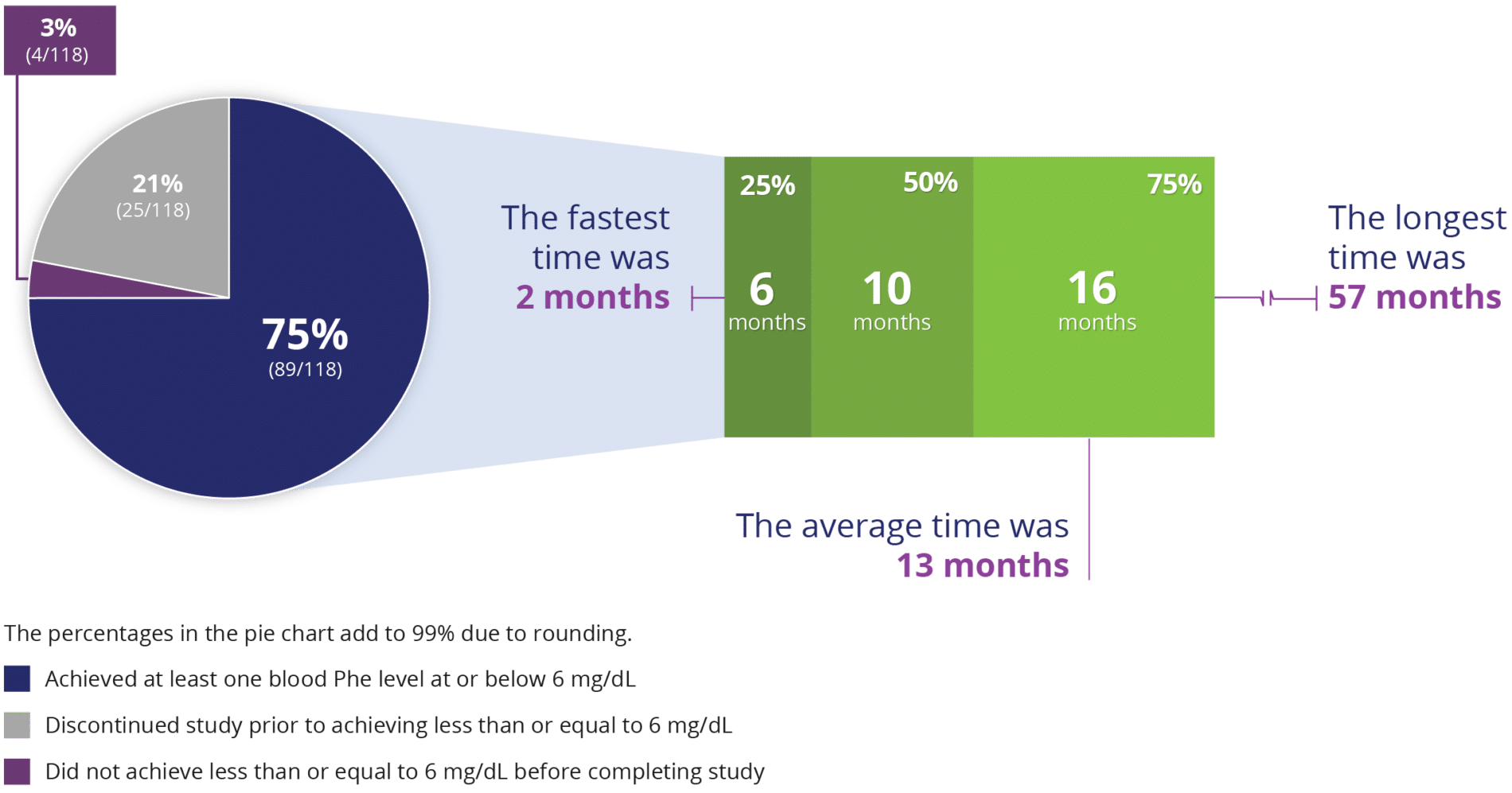With PALYNZIQ…

*46 of 93 patients who stayed in the clinical trial.
†57 of 86 patients who stayed in the clinical trial.
261 patients enrolled in the phase 3 clinical trial and 54 (21%) discontinued treatment during the first part of the study. As the study progressed, additional patients discontinued. Discontinuations occurred for a number of reasons, including adverse events, withdrawal by participant, physician decision, lost to follow-up, other, protocol deviation, and pregnancy.
In the second half of the clinical trial, 86 patients who saw 20% reductions in blood Phe levels entered an 8-week randomized withdrawal period. During this period, 58 patients continued on PALYNZIQ, while 28 patients received a matching placebo. On average, the patients who stayed on PALYNZIQ saw continued blood Phe reductions (down to 9 mg/dL), while the patients who received a placebo saw a significant rise in blood Phe (up to 25 mg/dL).
Hear firsthand from real adults with PKU about the process of lowering blood Phe levels.
Blood Phe levels varied over time and reaching a level less than or equal to 6 mg/dL does not mean that the patients stayed at or below that level. This chart shows how long it took them to achieve this Phe level in the study period.

When you start PALYNZIQ, you’ll stick with your current diet. As your blood Phe is measured over time, your clinic team will advise you about possible changes to your diet.


‡A Phe-restricted diet was defined in clinical trials as >75% of protein intake from medical food.

Below are the characteristics of patients who entered the study.§






In a randomized withdrawal period, patients|| were randomized to either continue their maintenance PALYNZIQ dosage or to receive matching placebo for a total of 8 weeks. PALYNZIQ-treated patients maintained their lowered blood Phe levels, whereas patients given the placebo returned to their pretreatment baselines.
§ITT, intent-to-treat; these are patient baseline characteristics in the phase 3 program. The majority of patients were on an unrestricted diet prior to and during the study.
‡Determined by whether a patient achieved at least a 20% reduction in blood phenylalanine level from pretreatment baseline.


What is the most important information I should know about PALYNZIQ?
PALYNZIQ can cause a severe allergic reaction (anaphylaxis) that may be life threatening and can happen any time during treatment with PALYNZIQ.
Severe allergic reactions are a serious but common side effect of PALYNZIQ.
Stop injecting PALYNZIQ and get emergency medical care right away if you have any of the following symptoms:
Keep the auto-injectable epinephrine with you at all times during treatment with PALYNZIQ. Read the Patient Information that comes with the auto-injectable epinephrine that your healthcare provider prescribes for you for more information.
If you have a severe allergic reaction, do not continue to take PALYNZIQ until you talk with your healthcare provider. Your healthcare provider will tell you if you can continue treatment with PALYNZIQ.
People taking PALYNZIQ have also experienced allergic reactions other than anaphylaxis. Talk to your healthcare provider if you experience any allergic reactions when taking PALYNZIQ.
PALYNZIQ REMS: PALYNZIQ is available only through a restricted program called the PALYNZIQ REMS (Risk Evaluation and Mitigation Strategy). Talk to your healthcare provider about the PALYNZIQ REMS and how to enroll.
What should I tell my healthcare provider BEFORE starting PALYNZIQ?
Tell your healthcare provider about all the medicines you take, including prescription and over-the-counter medicines, vitamins, and herbal supplements.
Before injecting PALYNZIQ, talk to your healthcare provider right away if you cannot or will not use auto-injectable epinephrine to treat a severe allergic reaction. If you are pregnant or plan to become pregnant while taking PALYNZIQ, talk to your healthcare provider to discuss the risks and benefits of taking PALYNZIQ during pregnancy to you and your unborn baby. If you are breastfeeding or plan to breastfeed, talk to your healthcare provider about the best way to feed your baby if you take PALYNZIQ.
Before injecting PALYNZIQ, read the Medication Guide and Instructions for Use that come with your PALYNZIQ injection.
What should I watch for AFTER starting PALYNZIQ?
PALYNZIQ may cause serious side effects, including:
The most common side effects of PALYNZIQ include injection site reactions (such as redness, itching, pain, bruising, rash, swelling, or tenderness), joint pain, headache, skin reactions that spread and last at least 14 days (such as itching, rash, or redness), nausea, stomach pain, vomiting, cough, mouth and throat pain, itching, diarrhea, stuffy nose, feeling very tired, dizziness, anxiety, and low levels of Phe in your blood.
These are not all of the possible side effects of PALYNZIQ. Speak with your healthcare provider right away about any side effects.
Blood Phe testing and diet
Missed dose
Pregnancy Surveillance Program
You may report side effects to BioMarin at 1-866-906-6100.
You are encouraged to report negative side effects of prescription drugs to the FDA. Visit www.fda.gov/medwatch, or call 1-800-FDA-1088.
Please see full Prescribing Information, including an important warning for risk of anaphylaxis, and the Medication Guide.
US-PAL-00519 02/25
What is the most important information I should know about PALYNZIQ?
PALYNZIQ can cause a severe allergic reaction (anaphylaxis) that may be life threatening and can happen any time during treatment with PALYNZIQ.
What is PALYNZIQ?
PALYNZIQ® (Pal-lin-zeek) (pegvaliase-pqpz) is a prescription medication used to lower blood levels of phenylalanine (Phe) in adults with PKU (phenylketonuria) who have uncontrolled blood Phe levels above 600 micromol/L (10 mg/dL) on their current treatment. You should discuss the potential benefits and risks of PALYNZIQ with your healthcare provider.